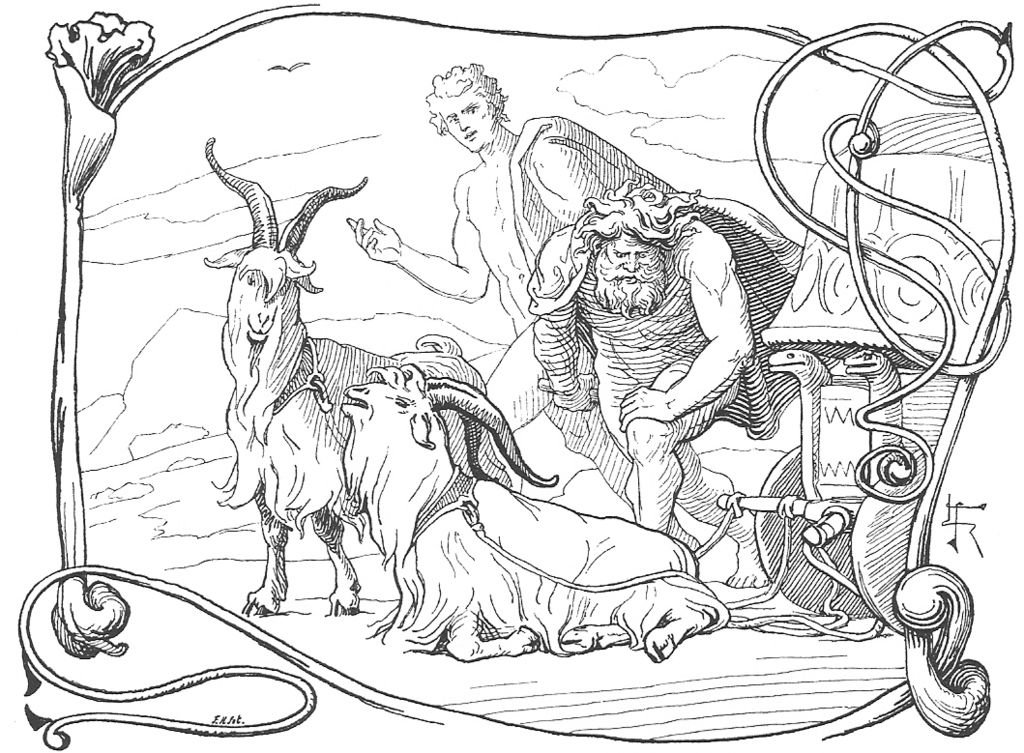In Norse mythology, Tanngrisnir and Tanngnjóstr are the two goats that belong to Thor. Their names translate to “teeth-barer” and “teeth-grinder” respectively. Thor’s goats have a crucial role as they draw Thor’s chariot across the sky, enabling him and his companions to travel to any of the nine realms.

Their arrival is easily recognizable to others, as the chariot’s movement produces sparks, lightning, and the resounding thunder that can be seen and heard from a great distance. Thus, when the mighty chariot moves, it announces the presence of Thor in a spectacular and awe-inspiring display.
How did Thor get his Goats?
In the Poetic Edda poem Hymiskviða, Thor and a human named Egil take charge of his impressive goats with “splendid horns,” in the realm of Midgard. Accompanied by the god Tyr, Thor embarks on a journey to the hall of the jötunn Hymir. Later in the same poem, Thor is called the title “lord of goats” as a testament to his ownership and mastery over these magnificent creatures. The names of Thor’s goats are listed among various goat names in chapter 75 of the Prose Edda, further solidifying their significance in Norse mythology.
Thors Goats in Norse Sources
In both the Prose Edda, penned by the Icelandic historian Snorri Sturluson, and the Poetic Edda, Thor’s goats are celebrated figures. According to the myth, Thor, in need of sustenance during his journeys, would consume his goats but then miraculously resurrect them with the power of his mighty hammer, Mjölnir.

During an adventure to Utgard accompanied by Loki in the Poetic Edda, Thor, and his companion decided to seek shelter at a humble farm in Midgard. However, the poor farmer and his family had nothing to offer as food. Showing his generous nature, Thor suggested cooking his goats and sharing the meal with the family, but with a condition – they must not break any of the bones and instead place them on a skin laid on the floor.
During the meal, the mischievous Loki persuaded the farmer’s boy Thjalfi to break one of the bones and taste the sweet marrow. Upon waking the next morning, Thor dressed and used Mjölnir to revive the goat, only to notice that it was now limping. Enraged, Thor demanded to know who had broken the bone, and Thjalfi confessed to his wrongdoing. As a consequence, Thjalfi and his sister Röskva became servants to Thor and his family. The tale leaves the question of which goat was hurt and whether the limping became permanent remains shrouded in mystery.
Relation with Scandinavian Shamanic Folklore
Modern scholars have made connections between Tanngrisnir and Tanngnjóstr and the beast Sæhrímnir. This creature is consumed nightly by the gods and the einherjar (fallen warriors in Valhalla) and is rejuvenated every day. This association has led some researchers to speculate about possible sacrificial rites in ancient shamanic practices.
In Scandinavian folklore, tales of witches who magically replenish food, often herring, have been passed down. These stories indicate that breaking the bones of the replenished food ends the rejuvenation. This intriguing link hints at a potential connection between these folk tales and the legendary goats of Thor.
Thor’s Goats in Pop Culture
In the Marvel Comics depiction of Thor, he often employs his enchanted hammer to fly. Yet, when he needs to transport others or objects, Thor calls upon his trusty goats, Tanngrisnir and Tanngnjóstr. These majestic goats arrive at his command, already harnessed to his chariot, and can be dismissed just as effortlessly. In the movie Thor: Love and Thunder, the iconic goats make an appearance as perpetual screamers.
